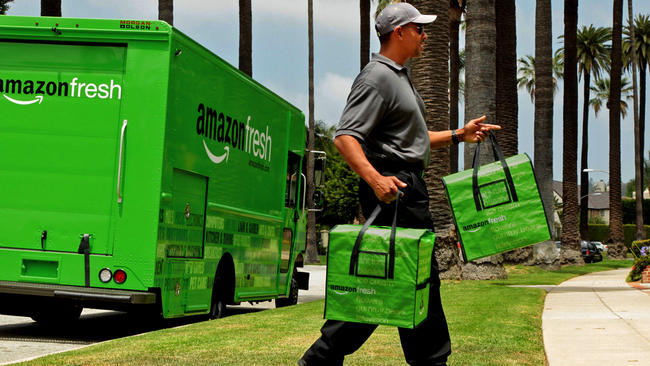By Laura Michaels
In a ring filled with retail heavyweights, Amazon is the hulking value giant. The Seattle-based online retailer, grocery chain, filmmaker, foodservice equipment supplier and yes, bookstore, is worth more than Walmart, Costco and Target combined, reports Fortune, as Amazon’s stock has nearly tripled in value over the last two years.
With its stock hitting above $900 per share last week, Amazon’s valuation soared to $439.8 billion. The combined total value for Walmart, Costo and Target, meanwhile, is $321.5 billion, but Amazon does still lag behind Walmart’s $482 billion in revenue.
Reports correlate Amazon’s recent investor success with, as Fortune’s Jeff Bukhari put it, “the market regression of its rivals,” as he noted Walmart’s and Target’s stocks are down around 15 percent and 30 percent since 2015, respectively, while Amazon’s is up nearly 200 percent during that same period. The Street Ratings April report details Amazon’s “impressive record of earnings per share growth, compelling growth in net income, good cash flow from operations and expanding profit margins.”
But for all the rosiness tinting the picture, Amazon is facing challenges with one of its most significant initiatives. AmazonFresh, the company’s key online ordering push into the $800 billion grocery industry, is battling on multiple fronts, reports Bloomberg in its in-depth analysis. From packaging and food waste to struggles enticing shoppers—in large enough numbers, anyway—to buy their bananas, beef and cheese online, Amazon, like its competitors, is looking for ways to dominate the grocery segment.
After expanding the AmazonFresh delivery program to several new cities last year and lowering the price from $299/year to $15/month, the company unveiled its cashierless convenience store, Amazon Go, in December but has yet to open it to the public. Similar brick-and-mortar stores, Bloomberg reports, could play a key role in Amazon’s grocery efforts as it tests AmazonFresh Pickup locations in Seattle, where its Prime members can order groceries online and pick them up via a drive-thru depot.
Direct partnerships with major food and consumer packaged goods makers also appear to be part of Amazon’s strategy to corner the grocery market, as the company reportedly invited the likes of General Mills and Mondelez to visit its headquarters for a discussion about selling directly to shoppers and bypassing the big box stores.
There are conflicting views on opportunities within the online grocery space, however, with Kurt Jetta, CEO of TABS Analytics, a consumer products research firm, telling Bloomberg that “online grocery is failing.”
“There’s just not a lot of demand there,” he said, noting the firm’s annual survey showed only 4.5 percent of shoppers made frequent online grocery purchases in 2016. “The whole premise is that you’re saving people a trip to the store, but people actually like going to the store to buy groceries.”
Meanwhile, a forecast released earlier this year by Food Marketing Institute and Nielsen said the potential is there for five-fold growth in online grocery shopping over the next decade. The forecast noted U.S. consumers could spend more than $100 billion on food-at-home items by 2025.
“Grocery shopping will reach digital maturity and saturation faster than other industries that went online before, such as publishing or banking,” said the report. “Younger, newer and more engaged digital shoppers adopt digital technologies more quickly, and will hasten the expansion of digital grocery shopping further.”
Online retail in the U.S. has evolved into a “mature, mainstream, and integrated industry with multiple offline channels,” noted The Street Ratings in its industry analysis. The next phase of growth, however, will require innovation and investment in technologies that “optimize the connection between online and offline elements. Failure to address risks associated with payment methods, credit card fraud and other consumer fraud could hamper sales growth.”
For its part, “Amazon wants to be the first thing any consumer thinks of when they need to buy anything,” said Jim Hertel, a senior vice president at marketing technology company Inmar Inc., told Bloomberg. “Food is the largest retail category. They can’t do what they want to do without grocery and they’re definitely not going to give up.”


